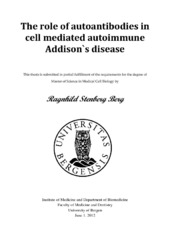The role of autoantibodies in cell mediated autoimmune Addison`s disease
Master thesis
Permanent lenke
https://hdl.handle.net/1956/5937Utgivelsesdato
2012-05-31Metadata
Vis full innførselSamlinger
Sammendrag
Background: Addison`s disease (primary adrenal insufficiency) is a prototypic organ-specific autoimmune disease affecting the adrenal cortex. Autoimmune Addison`s disease (AAD) is often characterized by autoantibodies against intracellular cytochrome p450 enzymes, in particular 21-hydroxylase (21OH) which is central in the steroid hormone synthesis of cortisol and aldosterone. AAD is thought to be T-cell mediated, but these 21OH-autoantibodies (21OH-aab) may still play a central role. Our hypothesis is that 21OH-aab may contribute to an enhanced T-cell response against 21OH leading to an autoimmune attack against the adrenocortical cells. Aim: This study aimed to investigate the role of autoantibodies in antigen processing and presentation in the pathogenesis of AAD. Methods: Total IgG from patients and healthy controls were purified chromatographically and were detected as 21OH-aab by western blot and ELISA analyzes. The ability of 21OH-aab to enhance T-cell responses against 21OH was evaluated in an ex-vivo interferon-gamma (IFN-γ) ELISPOT assay, using peripheral blood mononuclear cells (PBMC) pre-stimulated with 21OH protein or 21OH protein in complex with 21OH-aab. LPS-matured monocyte derived dendritic cells (DC) pulsed with 21OH protein alone, or 21OH in complex with 21OH-aab were used to established short-term CD4+ and CD8+ T-cell lines. These T-cell lines were then tested against a 21OH peptide panel to determine if 21OH-aab could influence the repertoire of 21OH-derived peptides presented by DCs. Again, the production of IFN-γ, assayed by ELISPOT and ELISA, was used as readout for T-cell activation. In addition, the cytotoxic potential of the short-term CD8+ T-cell lines were evaluated in a lactate dehydrogenase (LDH) assay employing adrenocortical carcinoma cells, lymphoblastoid B cell lines, or autologous PBMC as targets. Results and conclusions: High levels of 21OH-aab was detected in Addison`s patients compared to healthy controls, and western blot analyzes confirmed that purified IgG-aab bound strongly to 21OH. The ex-vivo ELISPOT analyzes revealed an enhanced T-cell response in the presence of 21OH-aab. IFN-γ stimulated monocytes expressed both CD32 and CD64 Fcγ-receptors and blockade of these lead to a decreased T-cell response, suggesting for a more efficient uptake of immune complex through these receptors. However B-cells cannot be excluded due to their strong expression of CD32 receptors. T-cell lines induced by DCs pulsed with 21OH protein in complex with autoantibodies produced more IFN-γ when re-stimulated with 21OH protein and peptides compared to T-cell lines pulsed with 21OH protein alone. The peptide repertoire recognized by 21OH-specific T-cell lines was also enhanced in the presence of autoantibodies. To conclude 21OH-aab may have an important role in the pathogenesis of AAD.
